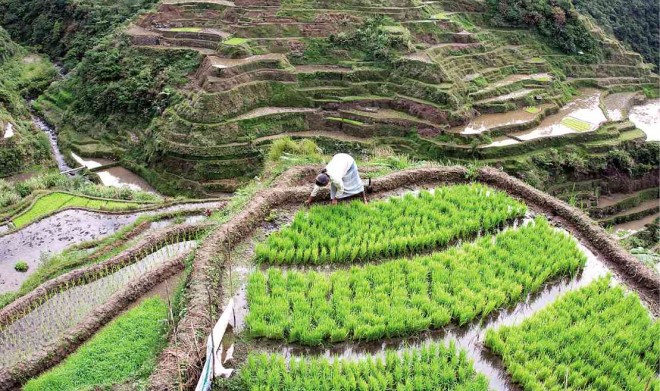‘Cultural awareness’ may save Ifugao rice terraces, says Legarda

A WOMAN tends the terraces where traditional rice varieties are grown in Banaue town, Ifugao province. EV ESPIRITU/INQUIRER NORTHERN LUZON
Following reports of deterioration as posed by threats of modernization, the once famed Ifugao Rice Terraces may be saved from total degradation if the public would realize its role as caretaker of the world heritage site, Senator Loren Legarda said.
Legarda, chair of the Senate committee on environment and natural resources, expressed alarm over the Agence France-Presse (AFP) report which said that “relentless forces of modernity” and “unregulated development” had been causing damage to the 2,000-year old stepped paddy fields.
“One of the biggest dangers being faced by the region is the abandonment of the so-called rice growing culture of the community as observed by the National Commission for Culture and the Arts,” she said in a statement, echoing the AFP report.
READ: Ifugao rice terraces may become urban jungle
“We need to instill cultural awareness among our youth as the future custodians of our heritage sites if we want to save the country’s cultural symbols from destruction,” she added.
Article continues after this advertisementThe AFP report quoted a statement of a mother living in one of the region’s villages, who said Ifugao children “refuse to go and work in the terraces” because of preoccupation with television and the Internet.
Article continues after this advertisementThe lady senator also said the removal of the Ifugao rice terraces from Unesco’s list of world heritage in danger should not make the public complacent, calling for immediate action on its present state.
“We have to immediately address growing concerns over the many issues surrounding the state of our rice terraces, in order to determine whether remedial measures must be introduced to ensure that this national treasure is sustainably protected,” Legarda said.
Six years after being named world heritage site, the Ifugao rice terraces was placed under Unesco’s list of world heritage in danger because of its deteriorating condition.
“I urge concerned government agencies, particularly the Ifugao Cultural Heritage Office, the local government units and citizens of the Cordillera Region to work together in protecting this heritage and ensure that various efforts are in place to save the Ifugao Rice Terraces from degradation, before it is too late,” Legarda added.
The AFP report also cited “ugly multistory buildings made of cheap concrete, polluting diesel vehicles, and ramshackle tin-roofed shanties” as factors that had been causing radical change in the site. Legarda said these changes diminished the “cultural and aesthetic values” of traditional Ifugao houses and villages.
Pests like worms and snails originally brought in as food were also reportedly causing some structures to collapse.TVJ